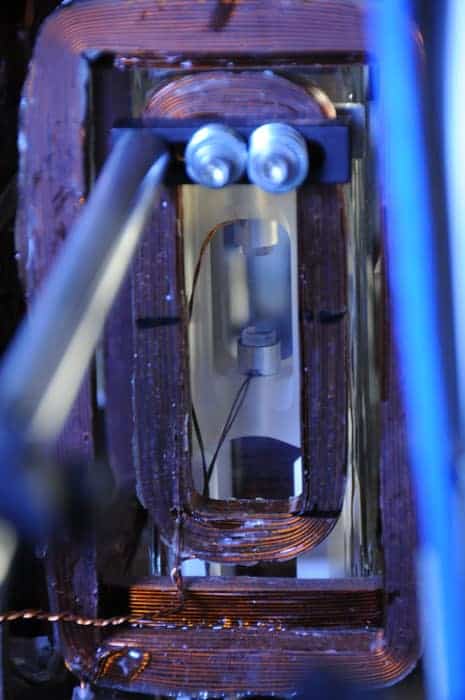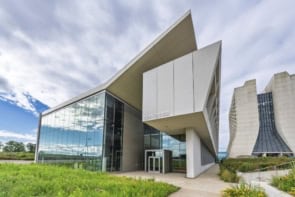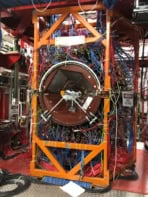
Radioactive atoms in a Bose–Einstein condensate (BEC) could form a “superradiant neutrino laser” in which the atomic nuclei undergo accelerated beta decay. The hypothetical laser has been proposed by two researchers US who say that it could be built and tested. While such a neutrino laser has no obvious immediate applications, further developments could potentially assist in the search for background neutrinos from the Big Bang – an important goal of neutrino physicists.
Neutrinos – the ghostly particles produced in beta decay – are notoriously difficult to detect or manipulate because of the weakness of their interaction with matter. They cannot be used to produce a conventional laser because they would pass straight through mirrors unimpeded. More fundamentally, neutrinos are fermions rather than bosons such as photons. This prevents neutrinos forming a two-level system with a population inversion as only one neutrino can occupy each quantum state in a system.
However, another quantum phenomenon called superradiance can also increase the intensity and coherence of the radiation from photons. This occurs when the emitters are sufficiently close together to become indistinguishable. The emission then comes not from any single entity but from the collective ensemble. As it does not require the emitted particles to be quantum degenerate, this is not theoretically forbidden for fermions. “There are devices that use superradiance to make light sources, and people call them superradiant lasers – although that’s actually a misnomer” explains neutrino physicist Benjamin Jones of the University of Texas at Arlington and a visiting professor at the University of Manchester. “There’s no stimulated emission.”
In their new work, Jones and colleague Joseph Formaggio of Massachusetts Institute of Technology propose that, in a BEC of radioactive atoms, superradiance could enhance the neutrino emission rate and therefore speed up beta decay, with an initial burst before the expected exponential decay commences. “That has not been seen for nuclear systems so far – only for electronic ones,” says Formaggio. Rubidium was used to produce the first ever condensate in 1995 by Carl Wiemann and Eric Cornell of University of Colorado Boulder, and conveniently, one of its isotopes decays by beta emission with a half-life of 86 days.
Radioactive vapour
The presence of additional hyperfine states would make direct laser cooling of rubidium-83 more challenging than the rubidium-87 isotope used by Wiemann and Cornell, but not significantly more so than the condensation of rubidium-85, which has also been achieved. Alternatively, the researchers propose that a dual condensate could be created in which rubidium-83 is cooled by sympathetic cooling with rubidium-87. The bigger challenge, says Jones, is the Bose–Einstein condensation of a radioactive atom, which has yet to be achieved: “It’s difficult to handle in a vacuum system,” he explains, “You have to be careful to make sure you don’t contaminate your laboratory with radioactive vapour.”
If such a condensate were produced, the researchers predict that superradiance would increase with the size of the BEC. In a BEC of 106 atoms, for example, more than half the atoms would decay within three minutes. The researchers now hope to test this prediction. “This is one of those experiments that does not require a billion dollars to fund,” says Formaggio. “It is done in university laboratories. It’s a hard experiment but it’s not out of reach, and I’d love to see it done and be proven right or wrong.”
If the prediction were proved correct, the researchers suggest it could eventually lead towards a benchtop neutrino source. As the same physics applies to neutrino capture, this could theoretically assist the detection of neutrinos that decoupled from the hot plasma of the universe just seconds after the Big Bang – hundreds of thousands of years before photons in the cosmic microwave background. The researchers emphasize, however, that this would not currently be feasible.
Sound proposal
Neutrino physicist Patrick Huber of Virginia Tech is impressed by the work. “I think for a first, theoretical study of the problem this is very good,” he says. “The quantum mechanics seems to be sound, so the question is if you try to build an experiment what kind of real-world obstacles are you going to encounter?” He predicts that, if the experiment works, other researchers would quite likely find hitherto unforeseen applications.

‘Superradiant’ laser created for first time
Atomic, molecular and optical physicist James Thompson of University of Colorado Boulder is sceptical, however. He says several important aspects are either glossed over or simply ignored. Most notably, he calculates that the de Broglie wavelength of the neutrinos would be below the Bohr radius – which would prevent a BEC from feasibly satisfying the superradiance criterion that the atoms be indistinguishable.
“I think it’s a really cool, creative idea to think about,” he concludes, “but I think there are things we’ve learned in atomic physics that haven’t really crept into [the neutrino physics] community yet. We learned them the hard way by building experiments, having them not work and then figuring out what it takes to make them work.”
The proposal is described in Physical Review Letters.



